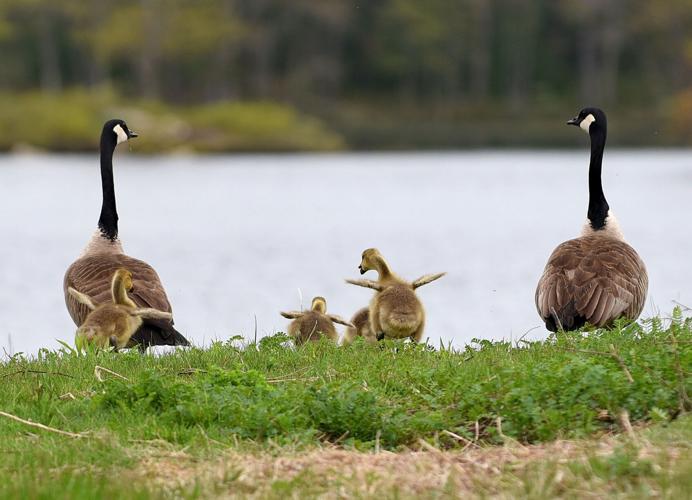I have never before seen a Canada goose (Branta canadensis) on one of my favorite Atlantic beaches until late this past winter. A small flock was paddling near the water’s edge. Later that week I saw a pair waddling around the grass area of the Portsmouth traffic circle.
They seem to be everywhere. According to the All About Birds website, the population of Canada geese has increased by approximately 7% every year from 1966 to 2019. Not surprisingly, they are of low conservation concern.

“Some 2.6 million Canada geese are harvested by hunters yearly in North America,” the site says, “but this does not seem to affect its numbers.” David Sibley’s “The Sibley Guide to Birds” identifies six populations of Canada geese — Aleutian, cackling, dusky, Richardson’s, lesser and common — whose differences include smaller bills, shorter necks, darker colors and overall size differences.
The largest is the common Canada goose, which is almost 4 feet in length and weighs around 10 pounds. The larger geese seem more southern in range. One Canada goose in the wild, according to Sibley, was recorded as living 28 years.
Many years ago (mid-’80s) when I lived in Allentown, Pennsylvania, the big park outside town where I would go to walk my big dog was heavily populated with Canada geese. These large geese leave large droppings, and complaints by park visitors were numerous. The geese had also started hanging out at a local school practice field, making the field unusable by the students.
The city’s solution was to round the geese up and drive them somewhere south. (As I recall they had made arrangements and didn’t just drop them off somewhere in the dark of night). The geese, not surprisingly, eventually flew back.
These large congregations obtain nuisance status pretty quickly. Cousin to the swan, Canada geese like grass, and thus are attracted to open lawns — especially when accompanied by their young — because they have a wide view of possible predators. Also, “geese, swans and whistling ducks,” according to Sibley, ”tend to have large, horizontally held bodies and long necks; the central position of the legs on the body facilitates walking when grazing on land.
” (This is the downfall of the loon, whose legs are so far back on its body that it cannot walk on land; it would topple onto its bill.) No wonder that Canada geese can be plentiful at golf courses, parks and airports where they become not only “nuisances” but safety hazards when planes collide with these large birds. Airports might be wise to eliminate grassy areas and maybe let any outlying areas grow up with wild grasses which the geese would not be as attracted to.
The All About Birds website describes the Canada goose’s favored nesting area — selected by the female — as slightly elevated and near water. The female also does all of the nest-building and the incubating while the male stands guard. They defend their territories with outstretched necks and all the other standard goose behavior that anyone with pet geese has experienced — hissing, honking, open bill ready to provide a strong pinch.
Pairs mate for life. “There is a series of visual and auditory displays given by a mated pair each time they meet after being apart” (A Guide to Bird Behavior, Volume I, Donald & Lillian Stokes). Once the goslings are mobile, the territorial defense by the male completely stops and the population of any given area can increase dramatically as adults are accompanied by as many as five young if all eggs hatched and survived.
The young hang with their parents for as much as a year. Sometimes, All About Birds says, more than one brood travels together although each pair has only one brood per year. Migrating Canada geese often don’t migrate very far.
They do tend to winter in the same area year after year. Migratory flights can be anytime during the day, but they will fly both day and night. I have been surprised hearing geese honking overhead while taking the dogs out well after dark.
Like with any wild animal, feeding Canada geese may be fun for humans but it is likely not good for the Canada goose’s welfare. First, they do not need to be fed by humans — clearly they are doing quite well on their own! Second, unless people learn the proper foods that a goose needs for nutrition (i.e.
, not bread), they are doing the birds harm. But mostly, feeding Canada geese makes them congregate in areas where they know humans will feed them. Encouraging them to flock to human-used areas like parks means that eventually there will be numbers large enough to make the geese considered a nuisance.
And that’s really not fair, encouraging them until it’s no fun for people anymore, and the animal pays through either extermination or the trauma of relocation..












